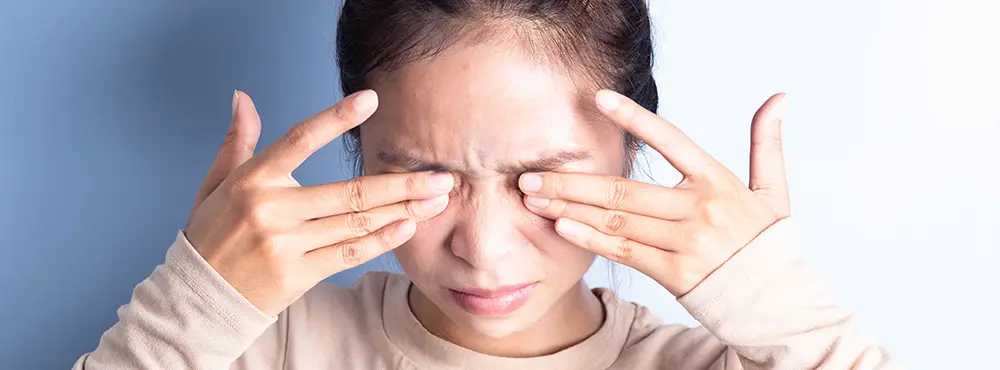Experiencing eye pain and aching eyes is not unusual; it's rarely a symptom of something to be concerned about. Aching eyes are often referred to as ophthalmalgia and usually goes away without requiring treatment.
You may experience aching eyes with eye pain that occurs deep within the eyes. This sort of eye pain requires more serious and in-depth treatment than eye pain that occurs on the surface of the eye.
When should I be concerned about eye pain?
You should be particularly concerned about eye pain if it is accompanied by vision loss as this can indicate a severe medical issue. If you experience loss of vision in addition to eye pain, you should contact your ophthalmologist immediately.
When is eye pain an emergency?
Eye pain is an emergency not just when accompanied by vision loss but also if you have the following:
- Severe eye pain
- Vision problems that occur suddenly
- Aching eyes caused by trauma
What causes eyes to ache?
Aching eyes can be categorized as ocular pain or orbital pain, depending on where the pain occurs.
What causes ocular pain?
Ocular pain occurs on the eye's surface. It can be caused by a range of factors, including the following:
What causes orbital pain?
Orbital pain occurs within the eye and can be caused by the following:
- Glaucoma - this causes a build-up of fluid in the eyes, putting pressure on the optic nerve
- Optic neuritis - this occurs when the optic nerve is damaged due to swelling and inflammation
- Sinusitis - an infection in one of your sinuses
- Iritis or uveitis - an inflammation inside your eye caused by infections or immune system problems
- Injury
- Migraine headaches
What does it mean when you have pressure behind your eyes?
A range of conditions including the following can cause pressure behind your eyes
- Migraines
- Grave's disease
- Toothache
- Injury to the face
- Sinus infections
- Optic neuritis (this can be a sign of multiple sclerosis)
Pressure behind your eyes can cause aching eyes despite being produced by the conditions above, which affect the tissue surrounding the face.
Diagnosing eye pain
You should see an eye care professional if you have eye pain. Using a variety of tools, they will be able to diagnose the cause of your eye pain. They may use a slit lamp to examine parts of the eye or dilating drops to expand the pupil, making it easier to see into the eye. A tonometer may be used to measure your eye pressure. This tool is often used to diagnose glaucoma.
How do I get rid of eye pain?
There are numerous ways to treat and get rid of eye pain. To treat aching eyes effectively, it is essential to know the cause of the pain. The following suggests common ways of getting rid of and soothing eye pain:
Warm compresses
If your eye pain is caused by blepharitis, your ophthalmologist may recommend using a warm compress to soothe your aching eyes. Applying a warm compress such as our Thera-Pearl Eye Mask can help to clear the clogged oil gland or hair follicle.
Rest your eyes
Giving your eyes a break from staring at a computer screen or mobile phone can help prevent dry eyes as well as get rid of pain such as eye strain.
Glasses
If you usually wear contact lenses, try switching to glasses for a bit. This will give your cornea time to heal.
Antibiotics
Aching eyes caused by infections such as conjunctivitis or corneal abrasions can be treated with antibiotics, eye drops or oral antibiotics.
Flushing
If your aching eyes are a result of foreign bodies in the eye, using saline solution or water can flush them out.
Eye drops
Those with glaucoma can reduce the pressure in their eyes with medicated eye drops.
Antihistamines
Antihistamine eye drops and oral medicines can treat eye pain caused by allergies.
Corticosteroids
Corticosteroids may be used to treat severe inflammation such as anterior uveitis (iritis) and optic neuritis.
Surgery
In rare cases, surgery is required to repair any damage caused by a foreign body in the eye or a chemical burn. Laser treatment is sometimes needed for those with glaucoma to improve drainage of the eye.
Pain medications
Your doctor may prescribe medications to ease eye pain until the condition is treated.
Why do my eye sockets hurt?
If your eye sockets hurt, this is usually related to problems with your sinuses. You'll experience pressure behind your eyeballs and throbbing pain which can be felt in the eye sockets. This is particularly true of sphenoid sinusitis.
Other symptoms which occur with eye pain
The following symptoms are common with eye pain:
Quick links:
A guide to glaucoma
A guide to eye infections
A guide to macular degeneration (AMD)
Disclaimer: The advice in this article is for informational purposes only and does not replace medical care or an in-person check-up. Please check with an eyecare professional before purchasing any products or remedies. For information on our article review process, please refer to our Editorial Policy.

 Offers
Offers Account
Account
 Favorite
Favorite
 Basket
Basket

 OFFERS
OFFERS
















